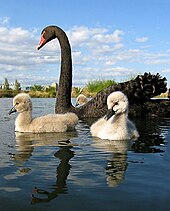 |
Black swan |
 |
| Black swan on Vacha reservoir, Bulgaria |
 |
| A black swan up-ending in deeper water to reach food |
 |
| A black swan up-ending in deeper water to reach food |
 |
| In flight |
 |
| Side view of mature adult showing characteristic "S" neck |
Black swan
The black swan (Cygnus atratus) is a large waterbird, a species of swan, which breeds mainly in the southeast and southwest regions of Australia. The species was hunted to extinction in New Zealand, but later reintroduced. Within Australia they are nomadic, with erratic migration patterns dependent upon climatic conditions. Black swans are large birds with mostly black plumage and red bills. They are monogamous breeders that share incubation duties and cygnet rearing between the sexes.
Black swans have been introduced to various countries as an ornamental bird in the 1800s, but have escaped and formed stable populations. A small population of Black swans exists on the River Thames at Marlow, and near the River Itchen, Hampshire. Described scientifically by English naturalist John Latham in 1790, the Black Swan was formerly placed into amonotypic genus, Chenopis. Black swans can be found singly, or in loose companies numbering into the hundreds or even thousands. Black swans are popular birds in zoological gardens and bird collections, and escapees are sometimes seen outside their natural range.
Description
Black swans are mostly black-feathered birds, with white flight feathers. The bill is bright red, with a pale bar and tip; and legs and feet are greyish-black. Cobs (males) are slightly larger than pens (females), with a longer and straighter bill. Cygnets (immature birds) are a greyish-brown with pale-edged feathers.
A mature black swan measures between 110 and 142 centimetres (43 and 56 in) in length and weighs 3.7–9 kilograms (8.2–19.8 lb). Its wing span is between 1.6 and 2 metres (5.2 and 6.6 ft). The neck is long (relatively the longest neck among the swans) and curved in an "S"-shape.
The black swan utters a musical and far reaching bugle-like sound, called either on the water or in flight, as well as a range of softer crooning notes. It can also whistle, especially when disturbed while breeding and nesting.
When swimming, black swans hold their necks arched or erect, and often carry their feathers or wings raised in an aggressive display. In flight, a wedge of black swans will form as a line or a V, with the individual birds flying strongly with undulating long necks, making whistling sounds with their wings and baying, bugling or trumpeting calls.
The black swan is unlike any other Australian bird, although in poor light and at long range it may be confused with a magpie goose in flight. However, the black swan can be distinguished by its much longer neck and slower wing beat.
One captive population of black swans in Lakeland, Florida has produced a few individuals which are a light mottled grey color instead of black.
Diet and feeding
The black swan is almost exclusively herbivorous, and while there is some regional and seasonal variation, the diet is generally dominated by aquatic and marshland plants. In New South Wales the leaf of reedmace (genus Typha) is the most important food of birds in wetlands, followed by submerged algae and aquatic plants like Vallisneria. In Queensland aquatic plants like Potamogeton and stoneworts and algae are the dominant foods. The exact composition varies with water level, in flood situations where normal foods are out of reach black swans will feed on pasture plants on shore.[13] The black swan feeds in a similar manner to other swans. When feeding in shallow water it will dip its head and neck under the water, and it is able to keep its head flat against the bottom while keeping its body horizontal. In deeper water the bird up-ends to reach lower. Black swans are also able to filter feed at the water's surface.


No comments:
Post a Comment